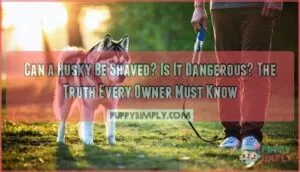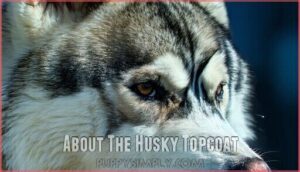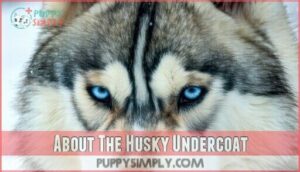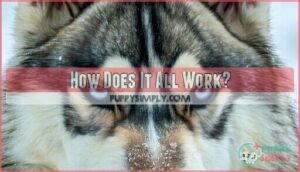This site is supported by our readers. We may earn a commission, at no cost to you, if you purchase through links.

Can a husky be shaved is it dangerous? Absolutely—shaving removes their double coat, which is their built-in climate control.
Without it, your pup risks sunburn, skin disease, and even overheating.
Fur won’t always grow back evenly, sometimes leaving patchy spots or itchy skin.
Plus, those guard hairs repel dirt and bugs, so you’d be taking away more than just fur.
There are safer ways to keep your husky comfortable, like regular brushing and targeted trims.
Want to know the key to a cool, happy husky?
There’s more to the story coming up.
Table Of Contents
- Key Takeaways
- The Dangers of Shaving a Husky’s Coat
- The Anatomy of a Husky’s Double Coat
- Alternatives to Shaving a Husky
- Understanding The Importance of a Husky’s Coat
- Frequently Asked Questions (FAQs)
- Should Huskies be shaved?
- What happens if you shave your Husky?
- Will a shaved Husky cause harm to itself?
- What is a shaved Siberian Husky?
- Can a husky shave a double coat?
- Does shaving help a husky to shed?
- Can shaving a husky’s coat help prevent overheating?
- Are there any alternative grooming methods for managing a husky’s coat?
- Will shaving a husky’s coat reduce shedding?
- Can shaving a husky affect their behavior long-term?
- Conclusion
Key Takeaways
- Shaving your husky strips away their double coat, ruining their natural climate control and exposing them to sunburn, overheating, and skin disease.
- Fur doesn’t always grow back evenly after shaving, so your dog could end up with patchy , damaged, or uncomfortable skin.
- That double coat does more than just shed—it repels dirt, bugs, and moisture, so shaving actually removes important protection.
- Stick to regular brushing and targeted trims instead of shaving to keep your husky cool, comfortable, and healthy.
The Dangers of Shaving a Husky’s Coat
Shaving your Husky’s coat takes away their natural protection and disrupts how they control body temperature.
Removing your Husky’s coat steals their natural shield and makes it harder for them to stay cool or warm
It also exposes their skin to sunburn, uneven regrowth, and a higher risk of skin disease.
Affected Temperature Regulation
When you shave your Husky, you strip away their natural insulation and disrupt how they manage heat control and cold stress.
Shaving your Husky removes their climate armor, leaving them vulnerable to both heat and cold—nature’s insulation gone
That double coat isn’t just for show—it’s a climate-adapt system.
Without it, your dog loses thermal balance. Instead of helping with temperature regulation, shaving can actually cause overheating, making it far harder for your Husky to climate adapt.
Improper Coat Regrowth
Regrowth struggles are a real headache for Husky owners.
When a coat tries to grow back after a shave, you may see patchy fur, coat damage, or lingering bald spots.
Matting problems can make regular brushing harder and even painful.
For your dog’s comfort, better to focus on husky coat care, proper grooming, and avoiding shaving dangers.
- Frustration when fur grows back unevenly
- Worry about lasting coat regrowth issues
Risk of Skin Diseases
When your Husky loses its coat, the skin is wide open to trouble.
Here are three ways this can lead to skin diseases:
- Skin loses protection against sunburn and skin cancer.
- Oil balance gets thrown off, so dryness and skin sensitivity set in, sparking dermatitis or coat damage.
- No coat means increased risk of skin allergies and parasite infestations, making infections much easier.
Proper Husky skin care is essential to prevent such issues and ensure your Husky’s skin remains healthy, avoiding dermatitis.
Embarrassing Your Dog
Beyond risks like skin diseases, there’s another side—imagine your pup facing the dreaded “Dog Shaming” moment.
Shaving exposes them to doggy disgrace, knocks down canine confidence, and invites pet embarrassment.
Huskies rely on their double coat for more than warmth; it’s part of their identity.
Skip the clippers—embrace proper husky grooming safety and let your dog strut with pride.
Understanding siberian husky shedding is essential to maintain their coat health and avoid unnecessary shaving, ensuring your dog’s overall coat health.
The Anatomy of a Husky’s Double Coat
Your Husky’s double coat works as a two-layer system that protects against heat, cold, sun, and moisture.
Each part—the topcoat and undercoat—has a specific job to keep your dog comfortable in every season, with the double coat being crucial for this purpose.
About The Husky Topcoat
Think of the topcoat as your Husky’s weatherproof jacket—it’s their first defense against the world.
The guard hairs in this layer do some heavy lifting:
- Repel moisture and dirt
- Block UV rays and insects
- Keep skin safe from cuts
- Reflect heat for comfort
- Support healthy coat texture
Regular husky grooming tips: brush, don’t shave, for lasting fur maintenance.
About The Husky Undercoat
This is where the magic happens: the undercoat acts as your Husky’s built-in insulation layer. It’s dense and fluffy, giving that iconic coat thickness and helping your dog manage hot and cold.
A healthy husky undercoat keeps temperature steady year-round, thanks to a natural shedding cycle and raking. Good care means fewer problems—and easier husky shedding solutions.
Understanding the natural coat health is essential for maintaining your Husky’s overall well-being.
How Does It All Work?
When you look at your Husky’s coat, you’re seeing a well-tuned insulation system with a double layer that works hard year-round.
It all comes down to:
- The topcoat acts like a raincoat, deflecting dirt, water, and sun rays—a critical part of their coat function and safety.
- The undercoat provides insulation, adjusting with the shedding cycle to maintain temperature control.
This natural system keeps your Husky safe, so shaving huskies isn’t just risky—it disrupts essential protection. Understanding the double coat benefits is essential to appreciating the complexity of their insulation system.
Alternatives to Shaving a Husky
Instead of shaving your Husky, try brushing them regularly and giving them a trim to manage shedding and keep their coat healthy.
Grooming sessions and cool baths can keep your dog comfortable without risking damage to their double coat.
Give Them a Trim and a Bath
Shifting from the wonders of a Husky’s double coat, let’s talk about simple ways to keep your dog comfortable—without the dangers of dog shaving.
Here’s how Coat Trimming and smart Bathing Tips can help:
- Trim the fur around paws and ears for better hygiene, using safe Grooming Tools.
- Bathe monthly to keep that coat healthy; use gentle dog shampoo.
- Brush before bathing for Shedding Control and easier Fur Maintenance.
- Adjust trims and baths based on shedding, following proven husky grooming tips and safe dog coat maintenance.
Proper dog care involves using the right Dog Grooming Tools to prevent skin irritation.
Brush Them Regularly
Grab your slicker brush and make daily brushing part of your routine. This simple act supports coat maintenance, shedding control, and prevents mats that can irritate your Husky’s skin.
Use gentle, steady strokes—good brush techniques target the dense undercoat, a cornerstone of dog grooming best practices. Regular brushing isn’t just one of the key husky grooming tips; it keeps your best friend comfortable.
Understanding the best brush options is essential for effective grooming and maintaining a healthy coat.
Take Them to a Groomer
After you’ve brushed your Husky regularly at home, sometimes you just need an expert’s touch.
A professional groomer knows the best strategies for keeping your dog’s double coat healthy without risking damage. Grooming Tips from an experienced pro go beyond a good brushing—they use tools and techniques like:
- Thinning Shears: These carefully trim the thick undercoat while keeping the fluffy insulation intact.
- De-Shedding Treatments: Specialized tools gently remove loose hair, preventing mats and cutting down on tumbleweeds around the house.
- Coat Conditioning: High-quality products keep skin and fur hydrated, supporting proper temperature control and Dog Hygiene year-round.
- Styling Options: Custom trims or touch-ups that don’t mess with your Husky’s built-in defenses against sun, bugs, and dirt.
Getting Professional Help means your dog’s coat gets the exact care it needs. Groomer Advice keeps your Husky cool, comfortable, and stylish—without risking the dangers of shaving huskies.
That’s dog grooming best practices you can feel good about. Regular use of proper grooming tools is essential for maintaining a healthy coat.
Understanding The Importance of a Husky’s Coat
After learning about smarter Husky grooming, it’s time to really see why their double coat matters.
This built-in jacket is more than just good looks—it acts as a climate adaptation tool.
The outer guard hairs work together with the soft undercoat to trap air, repel water, and protect against sun and bugs.
Skip dog coat shaving, and your Husky gets year-round comfort—a true win-win.
Shedding cycles may look messy, but that’s their body’s way to regulate temperature and prevent overheating.
Good husky hair care embraces this natural process.
When you manage coat shedding the right way, you help your dog enjoy the freedom of outdoor adventures without risking sunburn or skin issues.
Understanding husky coat care is essential for maintaining their health and well-being.
| Feature | Function |
|---|---|
| Double Layer | Insulation & climate control |
| Shedding Cycle | Temperature regulation & fur renewal |
| Guard Hairs (Topcoat) | Repels dirt, blocks UV rays, and insects |
Frequently Asked Questions (FAQs)
Should Huskies be shaved?
Sure, you can shave a Husky—if you’d also like to take away its natural air conditioning, sunblock, and raincoat all in one go.
Shaving ruins their double coat and leaves them vulnerable to weather and skin problems.
What happens if you shave your Husky?
When you shave your Husky, you strip away their natural climate-control system.
The coat loses its ability to protect from heat, cold, and sunburn.
Regrowth may be patchy, causing discomfort, skin issues, and permanent damage.
Will a shaved Husky cause harm to itself?
Shaving your Husky exposes their sensitive skin, raising the risk of sunburn, overheating, and skin disease.
Without that protective double coat, they lose their natural temperature control—think of it as tossing your winter jacket in a snowstorm.
What is a shaved Siberian Husky?
Fluffy fur falls flat—when you buzz your Siberian Husky’s double coat, you strip away its built-in climate control.
You’re exposing sensitive skin, risking overheating, sunburn, and patchy regrowth.
It’s more harm than help, honestly.
Can a husky shave a double coat?
You might wonder if you should give your Husky a close clip, but their double coat plays defense against heat, sunburn, and cold.
Removing it opens the door to skin damage, discomfort, and trouble controlling body temperature.
Does shaving help a husky to shed?
Think of your husky’s coat like a built-in air conditioner.
If you buzz it off, they’ll still shed—a lot, in fact!
Removing fur doesn’t stop the shedding; it just makes your dog more vulnerable to sunburn and overheating.
Can shaving a husky’s coat help prevent overheating?
Clipping your husky’s coat won’t keep them cool—actually, it strips away natural insulation.
Their double coat acts like a built-in thermostat.
Removing it leaves skin exposed and makes overheating and sunburn much more likely, as it disrupts the dog’s natural insulation.
Are there any alternative grooming methods for managing a husky’s coat?
Brush your husky’s coat regularly with a de-shedding tool to control loose hair and keep the fur healthy.
You can trim around the paws, ears, and sanitary spots, but never shave—brushing does the heavy lifting.
Will shaving a husky’s coat reduce shedding?
Shaving your Husky won’t cut down on shedding—instead, it kicks off more shedding from the faster-growing undercoat.
You’d just swap fluffy piles of fur for short, prickly hairs and possible long-term coat damage.
Can shaving a husky affect their behavior long-term?
When you shave a husky, you might disrupt their natural comfort, leading to anxiety or restlessness long-term.
It’s like taking away their favorite blanket during a storm—their coat helps them feel safe and balanced year-round.
Conclusion
Before you reach for those clippers, pause and consider why the question, “can a husky be shaved is it dangerous,” matters.
Removing their double coat disrupts natural temperature control, exposes your dog to skin risks, and leads to uneven regrowth.
While it’s tempting when summer hits, science says stick with safer options—regular brushing, targeted trims, and professional grooming.
Choosing these methods will keep your husky comfortable, protected, and healthy—no risky shortcuts needed to guarantee their well-being.
- https://www.akc.org/expert-advice/health/is-it-ok-to-shave-your-dog/
- https://huskygifts.com/can-you-shave-a-husky/
- https://alleysrescuedangels.org/learn/never-shave-a-husky.html
- https://www.americaspawspaw.com/the-hidden-dangers-of-shaving-double-coated-dogs-what-every-pet-owner-should-know/
- https://www.miragesiberians.com/dontshaveyoursiberian










